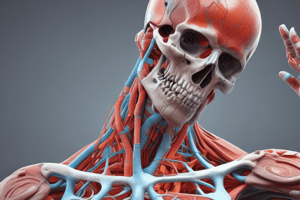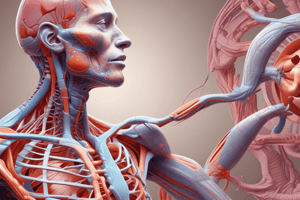Podcast
Questions and Answers
During concentric activation, the muscle contracts at a maximal velocity when the load is high.
During concentric activation, the muscle contracts at a maximal velocity when the load is high.
False (B)
A very large load in concentric activation results in a contraction velocity of zero.
A very large load in concentric activation results in a contraction velocity of zero.
True (A)
In eccentric activation, speed of lengthening decreases as a greater load is applied.
In eccentric activation, speed of lengthening decreases as a greater load is applied.
False (B)
Force-velocity curve shows that at higher velocities of contraction, the number of attached crossbridges is more.
Force-velocity curve shows that at higher velocities of contraction, the number of attached crossbridges is more.
During isometric state when velocity is zero, a maximal number of attached crossbridges exists.
During isometric state when velocity is zero, a maximal number of attached crossbridges exists.
In maximal-effort eccentric activation, muscle force is inversely proportional to the velocity of muscle lengthening.
In maximal-effort eccentric activation, muscle force is inversely proportional to the velocity of muscle lengthening.
The force-velocity relationship curve never reaches a zero slope.
The force-velocity relationship curve never reaches a zero slope.
As the load increases in concentric activation, the maximal contraction velocity also increases.
As the load increases in concentric activation, the maximal contraction velocity also increases.
If the agonist and antagonist contract simultaneously, co-contraction occurs.
If the agonist and antagonist contract simultaneously, co-contraction occurs.
A neutralizer muscle group assists the agonist or synergists in executing a movement.
A neutralizer muscle group assists the agonist or synergists in executing a movement.
The gluteus maximus is an antagonist of hip extension.
The gluteus maximus is an antagonist of hip extension.
Synergists of hip extension include the hamstrings.
Synergists of hip extension include the hamstrings.
Core muscles primarily function as neutralizers.
Core muscles primarily function as neutralizers.
Muscular force couple occurs when muscles produce forces in the same linear direction.
Muscular force couple occurs when muscles produce forces in the same linear direction.
A lever is a simple machine designed to convert force (F) into energy (E).
A lever is a simple machine designed to convert force (F) into energy (E).
For opposing torques to balance with unequal moment arm lengths, opposing forces must be of equal magnitudes.
For opposing torques to balance with unequal moment arm lengths, opposing forces must be of equal magnitudes.
In the open packed position of a joint, ligaments and joint capsule are most slack.
In the open packed position of a joint, ligaments and joint capsule are most slack.
KINETICS is the branch of mechanics that describes the motion of a body without regard to the forces that may produce the motion.
KINETICS is the branch of mechanics that describes the motion of a body without regard to the forces that may produce the motion.
Force can only be a pull and not a push according to Newton's second law.
Force can only be a pull and not a push according to Newton's second law.
A force (F) can be measured by the product of distance (d) and time (t).
A force (F) can be measured by the product of distance (d) and time (t).
Musculoskeletal forces are always referred to as loads when they act on the body.
Musculoskeletal forces are always referred to as loads when they act on the body.
In the loose packed position of a joint, ligaments and joint capsule are less slack.
In the loose packed position of a joint, ligaments and joint capsule are less slack.
Kinematics describes the effect of forces on the body.
Kinematics describes the effect of forces on the body.
The quantity of a force (F) is measured by multiplying velocity (v) by acceleration (a) according to Newton's second law.
The quantity of a force (F) is measured by multiplying velocity (v) by acceleration (a) according to Newton's second law.
Activation of muscle via the nervous system is done by beta motor neurons.
Activation of muscle via the nervous system is done by beta motor neurons.
Isokinetic muscle contraction involves constant angular velocity of the bony component throughout a range of motion (ROM).
Isokinetic muscle contraction involves constant angular velocity of the bony component throughout a range of motion (ROM).
Isoinertial muscle action involves muscles acting against a varying load or resistance.
Isoinertial muscle action involves muscles acting against a varying load or resistance.
The single alpha motor neuron, along with its innervated muscle fibers, is called a motor unit.
The single alpha motor neuron, along with its innervated muscle fibers, is called a motor unit.
The stretch immediately before the concentric contraction reduces torque production during the concentric contraction.
The stretch immediately before the concentric contraction reduces torque production during the concentric contraction.
The alpha motor neurons have their cell bodies located in the dorsal (posterior) horn of the spinal cord.
The alpha motor neurons have their cell bodies located in the dorsal (posterior) horn of the spinal cord.
In isokinetic exercise and testing, the angular velocity of the bony component varies continuously throughout a ROM.
In isokinetic exercise and testing, the angular velocity of the bony component varies continuously throughout a ROM.
Each alpha motor neuron connects with only one muscle fiber located within a whole muscle.
Each alpha motor neuron connects with only one muscle fiber located within a whole muscle.
FF muscle fibers are classified as FG indicating a slow twitch, oxidative histochemical profile.
FF muscle fibers are classified as FG indicating a slow twitch, oxidative histochemical profile.
FF motor units are usually recruited before the S motor units.
FF motor units are usually recruited before the S motor units.
Endurance and resistance training can result in a shift from Type IIb to Type IIa muscle fibers.
Endurance and resistance training can result in a shift from Type IIb to Type IIa muscle fibers.
Muscles with a higher percentage of fast-twitch fibers generate greater power at any given velocity of movement.
Muscles with a higher percentage of fast-twitch fibers generate greater power at any given velocity of movement.
The peak power of a muscle increases with velocity up to a movement speed of 100-200 degrees/sec.
The peak power of a muscle increases with velocity up to a movement speed of 100-200 degrees/sec.
At any absolute force, the speed of movement is lower in muscles with a higher percentage of fast-twitch fibers.
At any absolute force, the speed of movement is lower in muscles with a higher percentage of fast-twitch fibers.
Muscle fiber type cannot be changed from fast fibers to slow fibers through training.
Muscle fiber type cannot be changed from fast fibers to slow fibers through training.
Muscle fibers associated with larger motor units classified as FF are easily fatigue-resistant.
Muscle fibers associated with larger motor units classified as FF are easily fatigue-resistant.
Muscles are stimulated to contract through an afferent signal from the central nervous system.
Muscles are stimulated to contract through an afferent signal from the central nervous system.
Deep muscles have a higher proportion of FG fibers compared to superficial muscles.
Deep muscles have a higher proportion of FG fibers compared to superficial muscles.
Flashcards are hidden until you start studying




